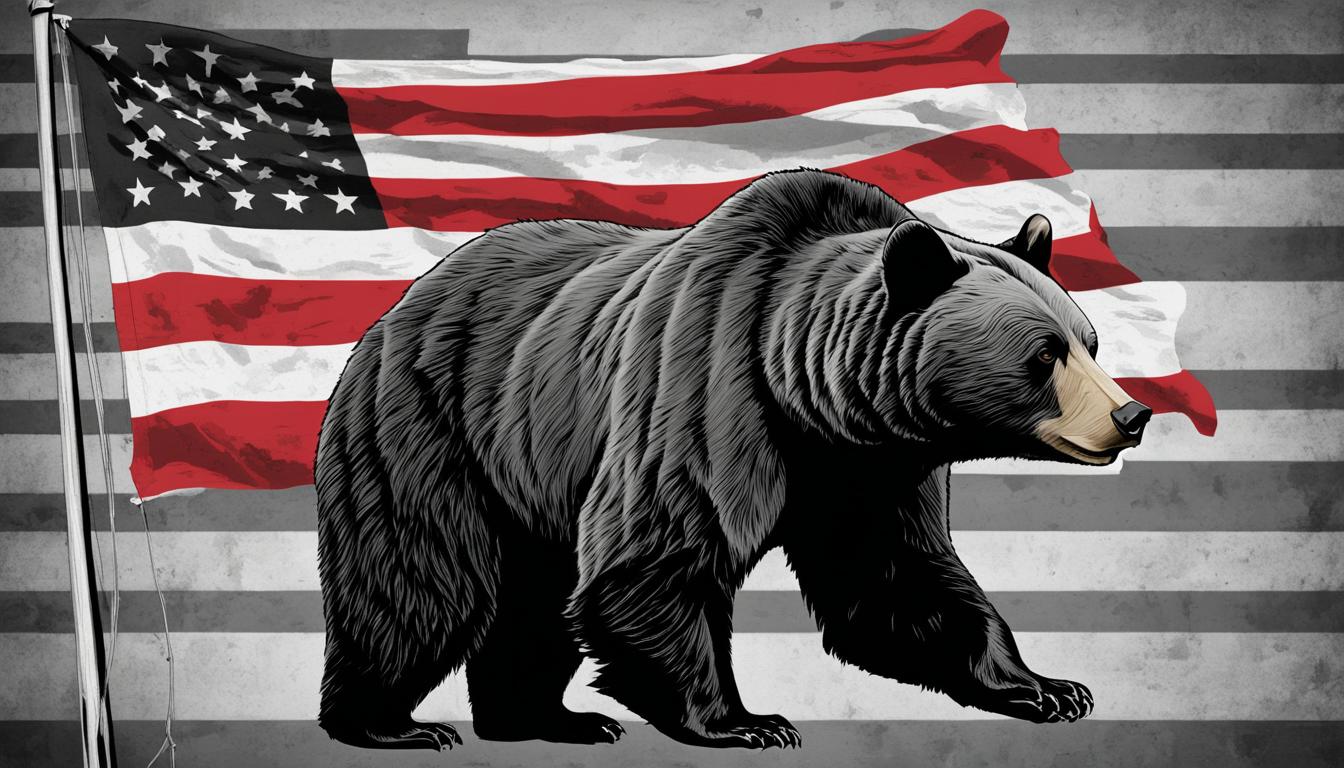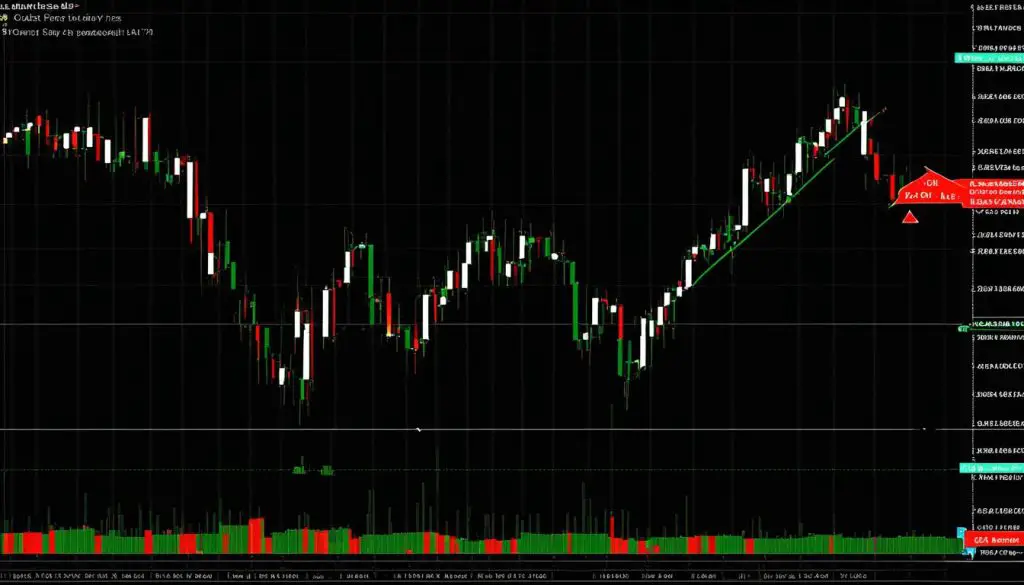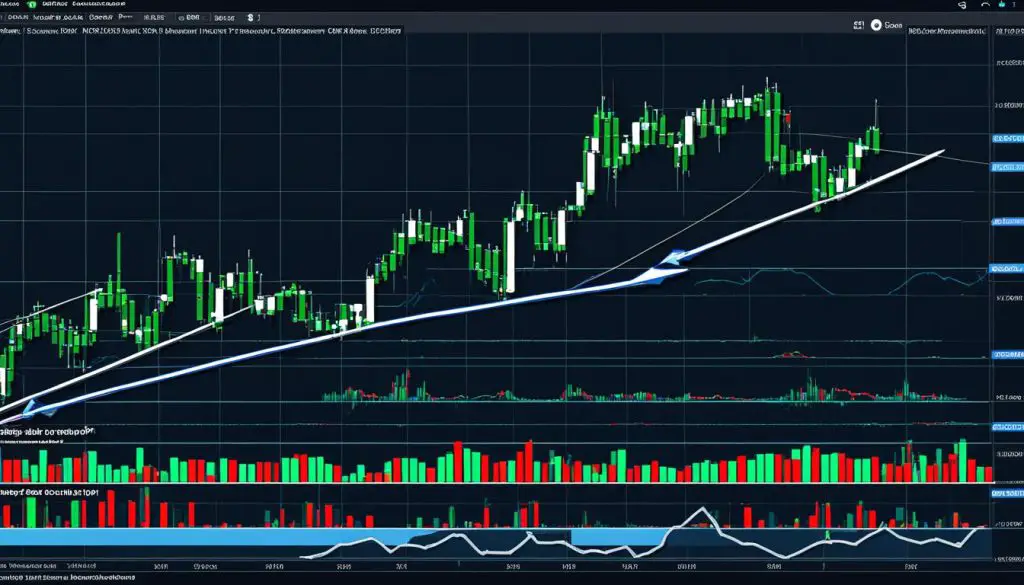Investors and analysts who closely monitor the beat of the stock market often encounter various chart patterns that signal future price movements. Among these patterns is the bear flag, a term seeped in bearish momentum and considered a harbinger of continued decline in the market. The bear flag definition encompasses a specific formation on the charts that typically spells out a pause in bearish price action, followed by a resumption of the downward trend. This signal is a critical component of bear flag stock market analysis.
Essentially, a bearish flag pattern constitutes two key phases: a steep, voluminous sell-off creating what’s known as the flagpole, and a subsequent, but typically mild, upward correction that forms the flag. With this pattern, traders infer a significant probability of sustained selling pressure, positioning themselves for potential entries as the pattern concludes and the downtrend resumes.
Understanding the Bear Flag in Market Trends
The bear flag chart pattern is a continuation signal often spotted by analysts conducting bear flag technical analysis during a market downtrend. Its unique structure of the bear flag formation indicates a likely extension of the existing downward trajectory.
Defining the Bear Flag Pattern
A bear flag pattern materializes with two key components: a sharp decline in prices, forming the ‘flagpole,’ followed by a minor, typically parallel, price consolidation phase, which forms the ‘flag’. While the flagpole suggests a sudden and forceful sell-off, the flag itself is characterized by a period of less aggressive selling and counter-trend buying, hinting at temporary indecision in market sentiment. This particular setup is crucial for traders as it may presage further price declines, suggesting the recent downtrend is not yet exhausted.
Psychology Behind the Bearish Sentiment
The creation of a bearish flag denotes a pause in momentum where investors and traders reassess the market’s strength. During the consolidation phase of the bear flag formation, wavering confidence among bulls often manifests as reduced volume and limited price recovery. This signals that despite attempts to push the market higher, bears are likely to regain control, continuing the dominant downward trend.
Comparing Bear and Bull Flags
Contrasting the bear flag with its counter pattern, the bull flag, sheds light on trend dynamics. The bull flag is the antithesis, forming during an uptrend with a corresponding indication of upward price continuation. Recognizing the difference between these patterns is central to understanding market sentiment and the potential movement of prices within the context of broader trends.
Both bear flag and bull flag patterns offer traders insights into potential future movements; however, recognizing the subtle signals within each pattern requires meticulous attention to detail and an understanding of the underlying market psychology driving these formations.
Identification of a Bear Flag on Trading Charts
Expert traders often look for the bearish flag pattern as a reliable indicator of market sentiment. This formation, consisting of a robust initial sell-off followed by a consolidative pause, captures investors’ attention as a hallmark of bear flag technical analysis. To effectively navigate the financial markets, it’s crucial to unpack the components of a bear flag and understand its technical implications.
The Anatomy of Bear Flag Formations
At the heart of the bearish flag pattern is the significant downward movement known as the flagpole. It represents a period of intense selling pressure where bears are firmly in control. This is typically followed by the flag itself, a minor upward correction that suggests a temporary halt to the selling frenzy. However, it’s important to note that this is often a pause in bearish momentum rather than a reversal. Lower trading volumes during this phase of the pattern signify a weakened conviction among traders betting on a sustained uptrend.
Spotting the Flagpole and Flag
To identify a bear flag technically, meticulous observation is vital. The flagpole is depicted by a swift and steep price decline. As for the flag, it can be seen as a smaller rectangle set against the direction of the prevailing trend, typically reflecting a more restrained selling volume. Traders scrutinize the charts seeking these elements before deciding on their strategy.
| Pattern Element | Description | Significance |
|---|---|---|
| Flagpole | Sharp downward price movement | Indicates strong bearish momentum |
| Flag | Consolidation phase with slight upward bias | Suggests temporary pause in bearish trend |
| Volume | Higher during flagpole formation, lower during flag | Validates the bearish sentiment within the pattern |
Recognizing and interpreting these elements demands a nuanced understanding of market psychology and price movements. This analytical approach is fundamental for traders relying on bear flag technical analysis to forecast potential market downturns and strategize their trades accordingly.
What Does Bear Flag Mean in Price Actions and Volume
The bear flag pattern has become a widely recognized signal amongst technical analysts monitoring the bear flag stock market activities. Keen observation of the bear flag volume patterns and bear flag price actions gives traders a strategic advantage, providing insights into potential future movements of the market. Let us delve into the intricacies of these patterns and their significance in forecasting market trends.
- Formation of the Flagpole: The onset of a bear flag is marked by a precipitous decline in stock prices. This drop, known as the flagpole, is typically accompanied by significant selling volume, reflecting the urgent exit of buyers from the market.
- Consolidation Phase: After a stark drop, the prices begin a modest and often hesitant recovery, forming the flag. Importantly, this phase generally occurs with diminishing trade volume, hinting at an underlying weakness in buying pressure.
- Breakout Indicator: The consolidation phase concludes with a breakout, often on a high-volume bar. This denotes the sellers returning with vigor, pushing the prices further down and continuing the bear market trend.
| Price Action Phase | Description | Volume Trend | Market Implication |
|---|---|---|---|
| Flagpole Formation | Sharp price drop indicating initial bearish sentiment | High volume of sales | Bears are in control, strong selling pressure |
| Flag Formation | Price consolidation following the initial drop | Declining volume, less trading activity | Uncertainty and lack of buyer conviction |
| Breakout | Price drops below the consolidation zone | Renewed high-volume selling | Continuation of bearish trend likely |
The careful scrutiny of these patterns equips investors with the capacity to deduce the probable future price trajectory. It highlights that the bear flag does not merely indicate a temporary retracement but rather a potential harbinger for a continued downtrend in the stock market.
Key Characteristics of the Bear Flag Pattern
The bear flag pattern’s distinctive properties make it a valuable tool in technical analysis. Unique in formation and implications, this pattern delivers traders with crucial insights into market sentiment and potential price movements. Unlike other chart formations that may suggest a trend reversal or a period of consolidation, the bear flag’s structure indicates a probable continuation of the current downtrend.
Bear Flag versus Other Technical Analysis Patterns
When we place the bear flag pattern alongside other common figures in technical analysis, such as wedges, triangles, or head-and-shoulders patterns, the bear flag definition becomes even more salient. The bear flag is characterized by a clear downtrend presence, signified by the sharp decline of the flagpole, followed by a slight upswing in price – the consolidation phase resembling a flag. This dual-phase composition serves as a market signal of bearish predominance over bullish efforts, where the resulting breakout almost invariably favors the bears.
Role of the Flagpole’s Length in Predicting Future Price Movements
Central to forecasting within the context of the bear flag formation is the role of the flagpole’s length. It’s not simply an initial drop-off point; rather, it’s integral to predicting the severity of the ensuing price movement. By analyzing the length of the flagpole, traders can project a similar length downward from the consolidation’s endpoint, to estimate the target of the bear flag pattern’s impact. This aspect of technical analysis bear flag can significantly aid traders in managing their expectations and adjusting their strategy to capitalize on or hedge against the anticipated price action.
FAQ
What Is a Bear Flag in Technical Analysis?
In technical analysis, a bear flag is a bearish chart pattern that indicates a potential continuation of a downtrend. It consists of a sharp decline in price, known as the flagpole, followed by a consolidating retracement phase within a narrow range, which forms the pattern’s “flag.” When the price breaks below the lower trendline of the flag, it suggests that the bearish trend may resume.
How Can You Identify a Bear Flag on Stock Market Charts?
A bear flag can be identified on stock market charts by looking for a significant decrease in price, which forms the flagpole, followed by a period of consolidation that creates a rectangular flag shape. The consolidation typically occurs with parallel upper and lower trendlines and appears as a slight, controlled rise in price against the prevailing downtrend.
What Psychology Drives the Formation of a Bearish Flag Pattern?
The psychology behind the formation of a bearish flag pattern involves a mixture of fear and hope among traders. After the initial sharp sell-off creates the flagpole, the consolidating flag phase reflects hope of a recovery among some traders, evidenced by attempts to push prices higher. However, because the buying strength is not enough to reverse the trend, the prevailing bearish sentiment takes over, leading to another potential sell-off after the pattern’s completion.
How does a Bear Flag Differ from a Bull Flag Pattern?
A bear flag pattern occurs during a downtrend and signals potential continuation of the decline, while a bull flag pattern occurs during an uptrend and indicates a potential continuation of the rise. Both patterns feature a flagpole and a flag, but they move in opposite directions, corresponding to the prevailing market trend—bear flags slope up slightly within a downtrend, and bull flags slope down slightly within an uptrend.
What Role Does Volume Play in Confirming a Bear Flag Pattern?
Volume plays a critical role in confirming a bear flag pattern. During the formation of the flagpole, there should be high trading volume, which suggests strong selling pressure. As the flag forms and the price consolidates, volume should decrease, indicating a lack of conviction among buyers. Finally, a breakout below the flag with an increase in volume can confirm the continuation of the bearish trend.
How do Traders Utilize Bear Flags in Market Analysis?
Traders utilize bear flags in market analysis as indicators of potential continuation of a downtrend. They may enter short positions or exit long positions when they recognize a bear flag formation, particularly if accompanied by high volume during the flagpole creation and a marked increase in volume on the downside break. Bear flags are used to gauge sentiment and provide strategic points for setting stop-losses or taking profits.
Can Bear Flags Be Used for Predicting Future Price Movements?
Yes, bear flags can be used for predicting future price movements. Traders often project the length of the flagpole downwards from the point of the breakout to estimate a potential target for the price decline. However, predictions based on bear flags, like all technical patterns, are not guaranteed and should be used in conjunction with other analysis methods and risk management strategies.
What Are the Key Elements of a Bear Flag?
The key elements to look for in spotting a bear flag include a significant initial downward move, the flagpole, followed by a consolidation phase forming the flag—often with parallel trendlines—against the prevailing downtrend. Lower trading volume during the flag’s formation compared to the volume during the flagpole’s creation is also indicative of a bear flag.
How Important Is the Volume Pattern During a Bear Flag Formation?
The volume pattern is very important during a bear flag formation. Ideally, volume should be high during the creation of the flagpole and diminish during the flag’s consolidation phase. A subsequent increase in volume on a downward breakout from the flag provides further confirmation of the bear flag pattern and the likely resumption of the downtrend.
How Can the Flagpole’s Length Help in Technical Analysis?
The flagpole’s length in a bear flag pattern can provide valuable insights in technical analysis. It can help traders to set potential price targets by projecting the length of the flagpole downwards from the breakout point. This measurement can offer a predictive aspect to the bear flag pattern, helping traders to make informed decisions on potential trade entries and exits.
What Differentiates a Bear Flag from Other Chart Patterns in Technical Analysis?
A bear flag is differentiated from other chart patterns by its distinctive flagpole and flag structure following a clear and sharp price decline. Unlike reversal patterns that signal a change in trend direction, bear flags are continuation patterns that suggest the downtrend is likely to persist. Volume patterns during the flagpole and flag phases also help to confirm the bear flag’s validity compared to other patterns that might display different volume characteristics.






